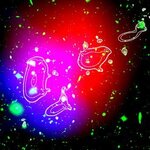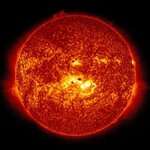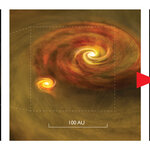Space

By observing a high-speed component of the massive galaxy cluster MACS J0717.5+3745, an extraordinarily dynamic cluster with a total mass greater than 1015 (a million billion) times the mass of the sun or more than 1,000 times the mass of our own galaxy, researchers have detected for the first time in an individual object the kinetic Sunyaev-Zel'dovich effect, a change in the cosmic microwave background caused by its interaction with massive moving objects. \
In 1972, two Russian physicists, Rashid Sunyaev and Yakov Zel'dovich, predicted that we should be able to see…
The surface of Venus is totally hostile to Earth life, a dim, hot furnace, with temperatures well over 400°C. But conditions are different at the Venus cloud tops. Temperatures are ideal, with plenty of light. The atmosphere is out of equilibrium, with H2S and SO2 present together, which life could use as a source of energy. Our orbiters have detected Carbonyl Sulphide - a clear sign of life here on Earth (though it could be created inorganically on Venus); and particles which are non spherical like microbes and the right size for them.
If we do find life there, it probably didn't originate…

The near-infrared vision of NASA's Hubble Space Telescope has given us a new view deep inside the Tarantula Nebula - and its more than 800,000 stars and protostars within.
Also known as 30 Doradus, the Tarantula Nebula is a region of star birth that resides 170,000 light-years away in the Large Magellanic Cloud, a small, satellite galaxy of our Milky Way. The Tarantula Nebula's vigorous star birth may be fueled partly by gas stripped from the Small Magellanic Cloud. One question researchers hope to answer is whether super-massive stars always form in clusters, or whether they can be born in…
This idea dates back to the Russians in the 1970s. The surface of Venus is far too hot, and the atmosphere too dense, for Earth life. However, our air is a lifting gas on Venus, with about half the lifting power of helium on Earth.
A habitat filled with an Earth atmosphere would rise naturally and float high in the dense Venus atmosphere, at a height where the pressure is 1 bar, i.e. same as the Earth atmospheric pressure at sea level. The temperature is also around the range tolerable for Earth life, over 0C.
Also, just as weather balloons naturally rise to its operating level high in our…

Messier 83, the Southern Pinwheel Galaxy, is one of the largest and closest barred spiral galaxies to us. At 15 million light-years away, it is one of the most conspicuous galaxies of its type in our skies. It's in the constellation of Hydra (The Sea Serpent) and is a prominent member of a group of galaxies known as the Centaurus A/M83 Group, which also counts dusty Centaurus A and irregular NGC 5253 as members.
Spiral galaxies come in a range of types depending on their appearance and structure -- for example, how tightly wound their arms are, and the characteristics…

The most scientifically interesting objects are not the bright blueish white ones in the center of the image, but the small reddish looking ones off to the sides. Here's how and why.
Astronomers working with the Hubble and Spitzer (infrared) space telescopes released an image showing some of the most distant galaxies ever by taking advantage of gravitational lensing due to the massive Pandora Cluster. Gravitational lensing is an effect in which the gravitational field of a large mass bends the path a ray of light will follow. This creates an effect predicted by Albert Einstein and…

Welcome to the first big solar flare of 2014.
The sun emitted a significant solar flare peaking at 1:32 p.m. EST on Jan.7, 2014. This is the first significant flare of 2014 and follows on the heels of mid-level flare earlier in the day. Each flare was centered over a different area of a large sunspot group currently situated at the center of the sun, about half way through its 14-day journey across the front of the disk along with the rotation of the sun.
Solar flares are powerful bursts of radiation. Harmful radiation from a flare cannot pass through Earth's atmosphere to physically…

Astronomers using NASA's Fermi observatory have made the first-ever gamma-ray measurements of a gravitational lens, thanks to B0218+357, located 4.35 billion light-years from Earth in the direction of a constellation Triangulum.
It's not really what it was designed to do. While radio and optical telescopes can resolve and monitor individual blazar images, Fermi's LAT cannot. Instead, the Fermi team exploited a "delayed playback" effect, which
opens new avenues for research, including a novel way to probe emission regions near supermassive black holes. It may even be possible…

Astronomers has discovered the first Earth-mass planet that transits its host star and found that KOI-314c is the lightest planet to have both its mass and physical size measured.
Though it weighs the same as Earth, it is 60 percent larger in diameter, meaning that it must have a very thick, gaseous atmosphere, they note.
The team gleaned the planet's characteristics using data from NASA's Kepler spacecraft. KOI-314c orbits a dim, red dwarf star located approximately 200 light-years away. It circles its star every 23 days. The team estimates its temperature to be 220 degrees Fahrenheit, too…

Using the new capabilities of the upgraded Karl G. Jansky Very Large Array (VLA), scientists have discovered previously-unseen binary companions to a pair of very young protostars, which gives strong support for one of the competing explanations for how double-star systems form.
Astronomers know that about half of all Sun-like stars are members of double or multiple-star systems, but have debated over how such systems are formed.
"The only way to resolve the debate is to observe very young stellar systems and catch them in the act of formation," said John Tobin, of the National Radio…